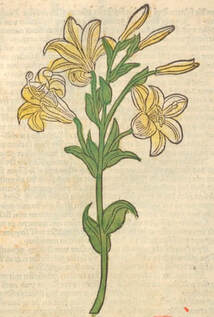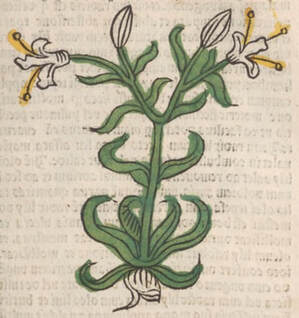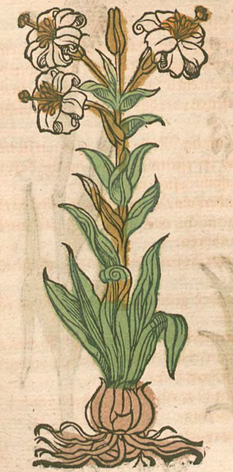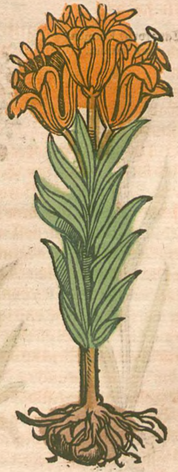Sentry Page Protection
Lilium candidum, White Lily
Rosa Junonis
Krauterbuch, Lonitzer, 1578
Atlas des plantes de jardins, Klincksieck, 1896
Botanical name:
Lilium candidum (syn. L. album)
Parts used:
Bulb (fresh and dried); Flower (fresh and dried)
Temperature & Taste:
Neutral, moist. Sweet. (Salmon said the flowers were Warm)
"Warm and moist in the first degree" (Herbarius latinus, Petri, 1485)
Roots: Digest, soften, ripen, cleanse
Flowers: ripen, digest, cleanse, anodyne
Classifications:
2J. RAREFYING
Lilium candidum (syn. L. album)
Parts used:
Bulb (fresh and dried); Flower (fresh and dried)
Temperature & Taste:
Neutral, moist. Sweet. (Salmon said the flowers were Warm)
"Warm and moist in the first degree" (Herbarius latinus, Petri, 1485)
Roots: Digest, soften, ripen, cleanse
Flowers: ripen, digest, cleanse, anodyne
Classifications:
2J. RAREFYING
Uses:
BULB
1. Clears Phlegm, Resolves Masses:
-hardness and Tumors, both topically and internally; especially of the Uterus and Testicles
-Cancers of Breast, Liver, Lung, Stomach, Colon, Testicle, Uterus (Duke)
-uterine bleeding and Uterine masses (internally and as a douche)
2. Promotes Urine:
-Edema, water retention (decoction)
3. Clears Heat and Poison:
-fresh root, stamped with white wine, the strained and taken, was claimed to expel the Plague via little blisters on the skin. (Gerard)
4. Externally:
-ripen tumors; hardness of the Testicles and uterus
-heat and inflammation
-Burns and Scalds
-Ulcers
-the roots were occasionally used internally to ripen and digest hardness and tumors
FLOWER:
1. Clears Heat, Stops Coughing and Wheezing:
-Cough, Wheezing, Shortness of Breath (primarily distilled Water)
2. Moves Qi, Calms the Mind:
-The distilled water was said to be very effective in Hypochondriasis and Hysteria (Tournefort)
3. Externally:
-flower-infused oil is applied to clear Heat and inflammation, ease pain, and ripen Tumors
-burns, scalds
-applied to cleanse the skin, remove wrinkles and whiten (oil or distilled water)
HERB:
Externally in Cataplasms or poultices for Inflammations and Gout
Dose:
Internally, the roots are decocted in water or milk, but were most used externally in oils, cataplasms, plasters etc. The flowers were most used externally in oils and distilled waters, the distilled water of the flowers being the most common internal remedy of them.
Comment:
The Lily was always viewed as a symbol of fairness and purity.
Internally, the roots are decocted in water or milk, but were most used externally in oils, cataplasms, plasters etc. The flowers were most used externally in oils and distilled waters, the distilled water of the flowers being the most common internal remedy of them.
Comment:
The Lily was always viewed as a symbol of fairness and purity.
Main Combinations:
1. The herb, made into a cataplasm with Henbane and Poppy leaf and Vinegar, applied to Gout. (Salmon)
2. Cough, Asthma, decoct the root with Marshmallow root in water and form a poultice with butter, apply to the chest. (Herbarius latinus, Petri, 1485)
3. To cleanse the skin, whiten and beautify the skin, the flowers the distilled water of the flowers mixed with Oil of Tartar and Camphor.
4. Hardness of the Uterus, Uterine Fibroids, as a fomentation with Marshmallow, Violet, Mugwort, Linseed and Fenugreek.
5. Cataplasm for Heat and Inflammation of the Uterus, Marshmallow, Camomile, Mugwort, Barley meal and White Lily oil.
6. Burns, boil the root in vinegar and apply (Herbarius latinus, Petri, 1485)
7. Tinnitus and Ear pain, decoct the root in oil and drop inn the ears.
Cautions:
None noted
Main Preparations used:
Infused oil of Lily flowers (Oil of Lilies)
1. Conserve of Lily:
i. Lily petals (1 part), White Sugar (3 parts). Triturate together.
2. Distilled Water of Lily:
i. Fresh Lily flowers (1 part), Water (4 parts). Distil one-half. (Pharmacopoeia Gallica, 1818)
3. Pulp of Lily:
i. Lily bulbs (any quantity); cleanse them, then wrap in paper and place them in hot ashes until sufficiently soft to be bruised between the fingers; remove the exterior and scorched parts, pound the remainder in a stone mortar and pass through a sieve. (Pharmacopoeia Gallica, 1818)
4. Oil of Lily:
i. fresh Lily petals (1 part), Olive oil (2 parts). Digest for 2 days in a water-bath; express when cold and repeat the maceration with fresh flowers. (Pharmacopoeia Sardoa, 1773)
ii. fresh Lily petals (1 part), Olive oil (4 parts). Digest for 2 days in a water-bath; express when cold and repeat the maceration with fresh flowers. Repeat a third maceration leaving the flowers to infuse for 3 months. (Pharmacopoeia Gallica, 1818)
iii. Lily petals, Olive oil (equal parts). Boil gently to the consumption of the humidity. (Dispensatorium medico pharmaceuticum Palatinatus, 1764)
None noted
Main Preparations used:
Infused oil of Lily flowers (Oil of Lilies)
1. Conserve of Lily:
i. Lily petals (1 part), White Sugar (3 parts). Triturate together.
2. Distilled Water of Lily:
i. Fresh Lily flowers (1 part), Water (4 parts). Distil one-half. (Pharmacopoeia Gallica, 1818)
3. Pulp of Lily:
i. Lily bulbs (any quantity); cleanse them, then wrap in paper and place them in hot ashes until sufficiently soft to be bruised between the fingers; remove the exterior and scorched parts, pound the remainder in a stone mortar and pass through a sieve. (Pharmacopoeia Gallica, 1818)
4. Oil of Lily:
i. fresh Lily petals (1 part), Olive oil (2 parts). Digest for 2 days in a water-bath; express when cold and repeat the maceration with fresh flowers. (Pharmacopoeia Sardoa, 1773)
ii. fresh Lily petals (1 part), Olive oil (4 parts). Digest for 2 days in a water-bath; express when cold and repeat the maceration with fresh flowers. Repeat a third maceration leaving the flowers to infuse for 3 months. (Pharmacopoeia Gallica, 1818)
iii. Lily petals, Olive oil (equal parts). Boil gently to the consumption of the humidity. (Dispensatorium medico pharmaceuticum Palatinatus, 1764)





